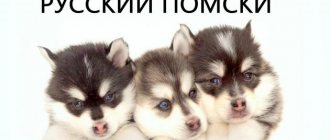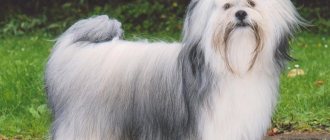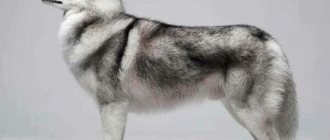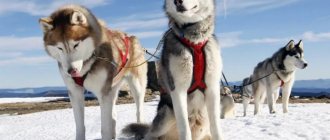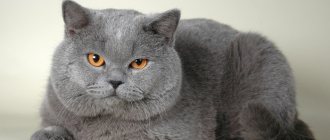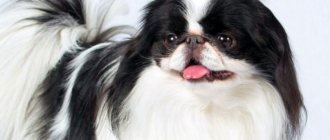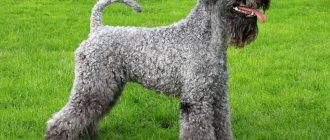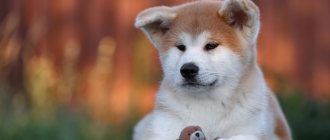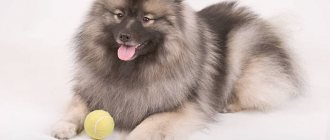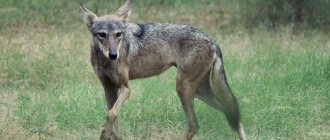Today, the husky's character has changed somewhat, although in the past they were considered only as sled dogs. Huskies are excellent companions, have a good time with children, and participate in racing and exhibitions. The breed has become famous all over the world thanks to its human-improved appearance. It is one of the most beloved and popular among many peoples. What types of huskies there are, with whom they can be easily confused, and other issues related to the care and education of representatives of the breed will be discussed below.
Character and behavior
These dogs are distinguished by their peacefulness and friendliness. They enjoy the company of dogs, people, and the attention of their owner and family. However, like all northern breeds, they are prone to dominance, willfulness and stubbornness. Huskies prefer to be free, although they unquestioningly obey the owner who can prove his leadership.
Animals are very active and need constant training. If the pet does not splash out energy, then it becomes destructive.
In the family they behave like perky family dogs, always ready to help. They treat their owner with trepidation and cannot tolerate long separations.
Basic rules of care
Huskies are unpretentious dogs.
They do not require complex care and all manipulations necessary to maintain the external attractiveness and health of the pet are reduced to a set of hygiene procedures, including:
- the washing up;
- combing;
- trimming nails;
- cleaning teeth and ears;
- rubbing the eyes.
The dog must also be vaccinated according to schedule and treated against fleas, ticks and helminths.
Expert opinion
Kozhevin Semyon Kirillovich
Expert dog handler.
The main thing that representatives of this breed need is regular active walks. Unable to get rid of the energy accumulated during the day, huskies suffer both psychologically and physically. It must be remembered that these are active dogs bred to work, so they need physical activity. Also, hygiene procedures, vaccination and treatment against parasites should not be neglected.
Attitude towards children
Even in the far north, it was customary to get a Husky when a baby was born in the house. It was believed that every child should have a dog.
The animals not only served as working dogs. They were nannies, toys, hot water bottles. In severe frosts, all the pets were gathered in a room to keep the children warm.
Huskies treat children of different ages with trepidation, play with them, and take care of them. They will protect babies from danger. The dog is considered a family dog, so it is suitable even for couples with newborns . Any angry or aggressive behavior is not observed among representatives of the breed.
How to train: what you need to know
- Husky is a working breed with a strong character. Boys try to dominate, girls are less inclined to lead, but in both cases they cannot be raised like sofa dogs, to indulge every whim. The owner must be a leader and constantly prove it. Do not succumb to the student’s tricks, persistently achieve the fulfillment of commands.
- Not suitable as a first pet. The owner of a husky must have knowledge and experience in training, and be self-confident. Professional trainers at our center will give advice on the proper training of dogs of any age and show how to conduct lessons.
- Teach useful skills gradually, without pressure. Play with your pet, communicate, become the “center of the universe” for him and he will obey you unquestioningly.
- The dog needs daily physical and mental exercise, otherwise it will direct its energy towards destruction. Recommended training courses: controlled city dog, obedience.
- Sled racing is the best use for the breed. Beginning of training (from 2 months) - accustoming to a harness and equipment. Wear them for a short time in the apartment or on a walk so that the puppy gets used to it quickly. Training a husky at home should consist of developing basic commands, without which interaction between the musher and the runner is impossible - forward, stop, right, left, past, impossible. From 10-11 months, he can pull a skier, provided that he skis well and only a small part of the weight rests on the dog. The first serious load is at the age of one year, when the bones become stronger. If you cannot put your pet in a harness, practice riding skills on walks - start teaching him with canicross or towing a tire. In Moscow, not all parks allow dogs, so it’s better to go outside the city where there is space for exercise.
- At temperatures above +16 degrees, it is advisable not to carry out training with loads. Warm weather can have a negative impact on your Husky's health.
Other articles:
- Exhibitions, ranks, titles, certificates, diplomas
- How to train pug dogs
Return to list
Relationship with the owner
A dog can have different relationships with its owner:
- The most common and correct model is the leadership of the owner and the obedience of the pet. If the Husky understands that a person is a leader, then he will obey him. This can be achieved through long-term training.
- Another acceptable model of relationships is fraternal. When the dog and the owner live and work on equal terms: they share food, bed, house, work together, performing their functions. Then the pet will consider the person an equal and obey him as a partner.
Two wrong parenting options: an idol dog and a rad dog.
In the first case, the family exalts the pet over its own needs, which is why the Husky becomes uncontrollable. In the second, the animal is abused, which destroys its psyche.
How to brush your teeth?
There is an opinion that since huskies have good health, there is no need to take care of the teeth and the general condition of the oral cavity of these dogs. This is wrong. The quality of primary food processing and its preparation for digestion depends on the condition and health of the teeth.
Poorly chewed food can lead to serious problems associated with your pet's gastrointestinal tract..
Diseased teeth provoke the formation and development of bacteria and toxins, which can get not only into the dog’s nose and ears, but even into the heart and lungs, and cause the development of inflammatory processes.
This is an indication that your husky has dental problems.:
- unpleasant odor from the mouth;
- redness of the gums;
- swelling of the muzzle:
- the appearance of blood or pus in saliva;
- noticeable damage to teeth;
- exposure of tooth roots.
To avoid such problems, it is necessary to take care of your pet’s teeth from puppyhood, preventing the appearance of plaque, which can lead to periodontal disease.
It is necessary to brush your pet's teeth daily using a special brush and toothpaste designed for dogs . It is important to ensure that the movements of the brush are not directed across the axis of the tooth.
You also need to regularly give your dog bones, tendons and other chewable objects - they help mechanically clean the teeth, which prevents the formation of plaque and tartar.
How do dogs get along with cats?
A husky can get along with cats only if they grow up together from childhood . They are even able to make friends. Otherwise, certain problems will arise, although with proper upbringing the dog will restrain its hunting instincts.
Due to the fact that dogs are pack animals, they are accustomed to living off their own feeding. Their habit of killing small animals for survival has still not been eliminated.
Behavior with other pets
All fur-bearing animals, birds, and livestock can become the object of sudden hunting. Huskies love to track game for food. Therefore, it is better not to keep this dog and other pets in the same house. If the dog lives on a farm, then all animals must be well fenced.
Can you keep it on a chain?
Huskies are active, cheerful dogs that need to be in constant contact with other animals and people; they need freedom..
In addition, representatives of this breed lack protective and watchdog instincts, and attempts to develop them and turn good-natured huskies into watchdogs negatively affect their psyche.
Huskies cannot be kept on a chain . On a leash, dogs do not have the opportunity to move freely, communicate and take part in the life of the family.
Such restrictions negatively affect not only the animal’s mental state, but also its overall health. Constantly keeping a dog on a chain dooms a dog to a life of depression and suffering.
At the same time, you should remember the characteristics of the husky , which consist in the desire to dig holes and jump over the fence in order to walk freely .
Therefore, for the safety of the pet, it can be tied up while the owners are away from home. But even in this case, the chain must be long enough - at least 4-6 m.
Strangers and Huskies
Due to its excessive friendliness, the breed cannot serve as a guard or simply protect property. Huskies do not consider strangers dangerous because they are used to being in the company of people and helping them.
As puppies, dogs adore everyone they see. They strive to get to know the whole world. Adult pets become more reserved, a little indifferent to people, and can be wary. However, any traits of aggressive behavior are considered unacceptable for this breed. Cases of outbursts of anger are very rare.
Diseases and vaccinations
Husky is an exceptionally hardy breed with strong natural health. And yet, in order to avoid possible problems, puppies need to be vaccinated from an early age.
The first comprehensive vaccination against common infectious diseases (distemper, enteritis, rabies) is carried out at the age of 8-9 weeks, and again after 3-4 weeks. Ten days before vaccination, the puppy is given deworming medication. After vaccination, home quarantine must be observed for another two weeks. Then the puppy can be taken for a walk. The dog will need the next revaccination at one year of age according to the same scheme.
It is important to protect your puppy from tick bites in the spring and summer. These parasites are carriers of the dangerous disease piroplasmosis, which can be fatal without treatment. As a preventive measure, you can use sprays, drops on the withers and anti-tick collars.
The weak points in the husky’s body that are most susceptible to diseases are the eyes, ears, skin, nervous system and joints. Sometimes puppies experience digestive upset, manifested in the form of diarrhea, lethargy, and lack of appetite. Body temperature may be increased. Most often, these symptoms occur due to dietary errors. In this case, you can give the baby sorbents against the background of a strict diet.
If the disorder does not go away on its own within two weeks, you should contact your veterinarian to prescribe medication. It will not be possible to protect your pet from all diseases, but proper nutrition and maintenance will help reduce the risks to a minimum.
Dog habits
Habits can be physiological, age-related or psychological:
- So, for example, during the period of changing teeth, you can notice your pet’s desire to try everything “to the teeth.”
- Another physiological bad habit is swallowing large pieces when receiving food . This is due to the fact that the animal tends to slow down its metabolism in order to stay full longer.
- Age-related habits include eating feces, stones, and branches. During the period of active growth, the puppy needs many useful microelements. With their deficiency, the pet tries the surrounding objects, getting used to their consumption.
- Another unpleasant feature is the tendency of male dogs to mark corners. This is due to the desire to show that the territory belongs to a certain pet. Simple education will help avoid this.
- Huskies love to dig holes. They can make digs or simply destroy flowerbeds for fun. They like to wallow in the ground and snow, and dig through garbage. During puppyhood, dogs are considered especially destructive.
- Despite the fact that the breed is classified as “quiet” (non-barking), one of the problems is howling. Most often, dogs whine out of boredom or to attract attention. This can be attributed to psychological habits.
Husky appearance
The color of a husky's eyes can be different.
Dogs of this breed are distinguished by very harmonious proportions.
Outwardly, they make a pleasant impression, very sweet and friendly. However, at the same time, such dogs have well-developed muscles, a wide chest and a clearly defined head. It is wide at the top and narrows closer to the muzzle. The husky has a medium-length muzzle, with expressive almond-shaped eyes that can be brown or blue. By the way, huskies are one of those dogs that most often have individuals with different eye colors.
Important! A characteristic feature of dogs of this breed is the close and slightly oblique position of the eyes. Some consider this a drawback, although this fact only emphasizes the uniqueness of the breed.
A husky has smooth white teeth with pronounced fangs. A scissor bite is mandatory for this breed. Any deviation from the norm is considered a defect.
The ears of this four-legged pet are triangular and pointed. Erect ears are one of the characteristic features of the husky.
Huskies are distinguished by their flat, strong back and muscular legs. The look is completed with a fluffy tail, very reminiscent of a fox's tail. It is bent in a ring and is often located on the dog’s back.
Let's talk separately about wool. The Husky has a thick coat with an extremely dense undercoat. This feature allows dogs to easily tolerate temperatures in the northern regions, dropping to -50°C and below. The coat itself is smooth and straight. A hard and shaggy coat is considered a fault of the breed.
As mentioned above, the color of dogs can vary from white to black. It is only important that there are white markings on the husky’s head, which create a kind of “mask” around the dog’s eyes. It is considered a characteristic feature of the husky.
Advantages of the breed
The owner determines the merits for himself, because all dogs are individual and differ in character. The main advantages of the breed are highlighted:
- Friendliness, positivity, affability;
- Openness, sociability, contact;
- Good intellectual abilities;
- Good relationships with relatives;
- Huskies rarely bark;
- There is no specific dog smell;
- Not aggressive;
- Mobility (remain active until old age);
- Dogs do not need large amounts of food;
- Strong immunity, endurance to cold and work.
How to bathe correctly and how often it should be done
The husky's coat is capable of self-cleaning, so representatives of this breed do not need frequent washing. The only thing you need to do regularly is wash the paws and belly of a dog living in an apartment after every walk.
You need to thoroughly wash your pet no more than once a quarter, using shampoo that matches the type and color of the coat .
First, you should thoroughly wet the topcoat and undercoat, then apply shampoo, lather it and rinse thoroughly with water, making sure that it does not get into the pet’s ears and eyes.
Before bathing your puppy for the first time, you need to lay a rubber mat on the bottom of the bathtub so that the dog’s paws do not slip..
After bathing, the dog should be dried with a terry towel and thoroughly dried with a hairdryer so that the undercoat does not remain wet.
Disadvantages and difficulties
Breed disadvantages include:
- Stubbornness and willfulness (like all northern dogs, Huskies love freedom, although they are used to living side by side with humans);
- Tendency to dominate in the family (the breed is a sledding breed, its representatives have worked for centuries in a pack, where it is important to show leadership qualities in order to become a leader);
- Tendency to run away (vagrancy is one of the main disadvantages of northern hunting and sled dogs);
- Strong hunting instinct (any bird or small animal in the eyes of a Husky is prey);
- Intolerance of loneliness (the pet constantly needs human attention);
- Dogs love to dig and chew;
- The need for high physical activity;
- Twice heavy molting (in spring and autumn);
- The breed is not suitable for beginners and requires training;
- Not suitable for security.
History of appearance
Husky is one of the 14 oldest breeds, bred in northeastern Siberia. The exact time of origin of these dogs is unknown, but scientists suggest that their age is 3 thousand years or more.
Huskies owe their appearance to the Chukchi, who lived on the Arctic coast for many centuries and needed hardy dogs suitable for driving long distances and transporting goods.
In addition, due to the lack of provisions, these dogs had to have a minimal need for food, despite significant physical exertion.
Smart, good-natured, fast and resilient, huskies met all the requirements. These dogs were kept both on the street and in yurts for the purpose of warming small children. The long-term isolation of the peoples of northeastern Siberia determined the long-term preservation of the purity of the breed.
NOTE!
Over time, Americans became interested in the breed, and in 1930 Huskies were recognized by the American Kennel Club, and in 1934 an official standard was adopted. The Canadian Kennel Club recognized the breed in 1939, and individual representatives of the breed were brought to Russia in 1995.
Interesting facts about the breed:
- Husky is a distorted version of the slang "Eski", which the Americans used to call Eskimos.
- Translated from English, “husky” stands for “husky”, since representatives of this breed do not bark, but make hoarse sounds.
- A husky team can travel about 250 km, reaching a speed of 25-35 km/h.
- In 1925, a husky named Balto was the leader of the team that brought diphtheria serum to Alaska, this story is shown in the Disney cartoon.
Behavior in the house and apartment
Pets are fussy in enclosed spaces . They can get used to life in the city, but there should be plenty of indoor space. The activity of the breed can be considered a disadvantage, especially if walks are rare and short. The animal will run, chew and damage objects, and howl. This can be weaned off in childhood, although the basis of good behavior is regular physical activity.
Huskies can be annoying and demand attention. If the dog is often left alone, it will become sad, lose interest in life, or become completely uncontrollable.
Is it possible to influence and correct the character of Siberian Huskies?
Raising and training a Siberian Husky is of great importance, as soon as you bring him into your home. Do not allow people to chew things, stop attempts to pester strangers while walking, do not allow them to eat from someone else’s hands, pick up food from the floor, or beg for food from you while eating. It is forbidden to jump on and bite people, even to show your love. Only training and proper upbringing will change a dog’s character for the better. The puppy training process is based on the method of motivation, encouragement and praise. It is prohibited and unacceptable to treat the dog harshly during training.
Behavior in the yard of a private house
If a Husky lives on the street, then he must be provided with the necessary conditions: a comfortable kennel or enclosure with a strong fence, a high fence, a place for running and active games.
Pets are accustomed to living in cold climates, so frosts will not frighten them, which cannot be said about heat. They like to wallow in the ground, snow, flower beds, and garbage. Therefore, it is worth protecting dangerous or expensive objects.
- Dogs are overly curious and often run away by jumping over the fence. Plus, they love to dig. To protect your pet, the exit should be lined with hard tiles, and for digging, organize a special place with a mountain of sand or soft earth.
- If livestock and poultry are kept nearby, the demarcation of the territory should be strong and high. These dogs mistake chickens and geese for prey. If they collide with a cow or horse, they may be trampled.
- One way or another, Husky will like this kind of life, even in an enclosure. Because in free conditions they can frolic as much as they want. A pet living on the street also needs less stress.
How to care for a husky
It is better to keep active, restless huskies in a private house with a plot or enclosure. They adapt to the apartment provided they are walked daily 2 times a day, for at least 1.5-2 hours. Outdoor games, overcoming obstacles, and hiking in unfamiliar places will be beneficial. The dog will get the necessary physical activity, burn off energy, and at home he will be calm and well-mannered.
The breed is very clean. The main thing is grooming. Self-cleaning coat must be brushed regularly, and brushed every day during the shedding period. It is enough to bathe 1-2 times a year. Carefully inspect the coat, skin, paws, ears after each walk, teaching hygiene procedures from childhood.
A puppy of 1.5-2 months is fed 5-6 times a day, gradually reducing the number of meals. At the age of 7 months you can switch to two meals a day, at 12 months - to an adult feeding regimen. ¾ of the diet is natural meat and fish. Last meal at 21-22 hours. Place food at the same time every day. Compliance with the regime has a positive effect on proper digestion and normal bowel movements of the husky.
With proper maintenance and care, huskies almost never get sick and live on average up to 14 years.
Behavior on the street
The dogs are very sociable, they love the company of their relatives, the puppies strive to sniff and play with everyone they meet. Males often run away when they smell a female. The owner must accustom the pet to the fact that it is always more interesting to be with a person. To do this, while playing with other animals, the owner needs to periodically call the puppy, give him treats, and concentrate his attention on communicating with the family.
In general, outdoor animals are active, playful and curious . They will not phlegmatically stroll around their owner; they need to study everything and get to know everyone. Huskies can chase cats and pigeons, although otherwise they react calmly to objects: they rarely bark and do not run after bicycles or cars.
During the winter season, pets love to play in the snow and even often sleep in snowdrifts. In the summer, they won’t refuse to swim in a pond or pool.
How to toilet train a puppy? How to stop shitting in your apartment?
You need to place as many newspapers or diapers in the house as possible, especially near doors, windows and in places where the puppy craps most often.
Over time, the number of diapers needs to be reduced until one remains, which needs to be gradually moved to a place that the owner has designated as the pet's toilet . When the husky remembers the place of the toilet, the diaper should be replaced with a tray.
You should not physically punish your puppy for urinating in the wrong place. It will be enough to verbally show dissatisfaction.
When your baby is allowed to go for walks, you will need to take him outside after each feeding and not return home until he goes to the toilet..
Features of walking without a leash
The breed is northern, bred for persistent hard work, transporting goods and people over long distances. Therefore, when going outside, the animal feels free. Huskies love to run a lot and for a long time, they are curious and rarely obedient, so they often get lost and run away. A weak and slow person will not be able to hold and later catch up with the dog. Many owners keep their pets off a leash to avoid such situations, although this breed needs free runs.
Very often, city authorities prohibit walking medium and large dogs without muzzles and leashes. In this case, the pet must be taken outside the populated area: to the river, to the landing, to the lake, avoiding public crowded places.
Dog handlers recommend teaching your Husky a leash from the first walks and not letting him go in urban environments until he is completely submissive, where the dog can get lost or get hit by a car. The animal needs to know all the commands and be able to carry them out under any conditions. Although this breed is difficult to train to obedience.
Basic commands
You will use some commands more often, others less often. But they will still come in handy to easily interact with the Siberian Husky and even keep him safe in various situations.
- Aport. One of the most difficult teams. Many people perceive it as very easy and simple, but with many dogs you will have to work hard. This skill is used for other exercises: searching, searching, selecting an item and many others. Usually they are all used in service. When working out a command, “Aport” and “Give” are used, and a gesture is also used.
- Give. On the command “Give” the dog must give up the object.
- Lie. A connecting command that needs to be learned for other commands. In addition, it will not interfere at home or on the street.
- To me. You will need to use this command quite often. So start with it immediately after your Siberian Husky puppy has learned his name. Never call the dog to punish, and do not scold if it comes on its own, even after mischievousness before it. This behavior on your part may alienate the animal.
- Place. A puppy or an adult dog must clearly know where his place is located. He can sleep anywhere, if you allow it, of course, but he must know this command. You can use it outside the home, marking the place with a leash or your favorite toy.
- Near. It is possible to teach your pet the “Near” command at any age, be it an adult dog or a small puppy. When you move to a new home, you should immediately think about training your puppy.
- Sit. One of the very first commands that a Siberian Husky puppy should learn.
- Stand. The command is useful in everyday life, for example, for combing a dog.
- . The prohibiting command is one of the most mandatory and taming it begins from the first day the puppy appears in the house. Requiring the command “Fu!”, “No!”, “No!” - immediately stop the unwanted action.
Who is the breed not suitable for?
- These pets are characterized by increased activity . They need to train a lot, walk, play. Therefore, Husky is not suitable for homebodies, sedentary people and elderly people.
- In addition, dogs are strong and fast. In case of escape, an unhealthy person will not be able to catch up with an animal that has not been trained in commands.
- Also, puppies need to be trained for a long time and persistently, accustoming them to the rules of behavior, walking and feeding regime . If the family is not prepared for the fact that at first the dog will not be obedient, neat and restrained, then getting a Husky is not recommended.
Even a teenager can work with representatives of the breed, because they learn quickly and easily. But the dog is best suited to an avid dog breeder who has already kept northern Laikas or similar pets. Although a beginner can practice his training skills with these doggies.
Training
At home, the behavior of these seemingly cute dogs is often destructive. They chew on sofas, climb on chairs and tables like cats, steal food from countertops and cause damage to any thing that is “in the wrong place.” But this is what representatives of this breed do in the absence of appropriate upbringing.
Training a husky will not be easy, because these animals are very capricious. Despite the warm feelings they have for their owner, dogs often distance themselves from him. To make them obey, you will have to show persistence and patience.
Unfortunately, in the process of training a husky, you cannot do without punishment. This is not about beating! Whenever the dog begins to behave badly, for example, barking loudly for no reason, you need to raise your voice at him, saying “Ugh” out loud.
He should associate this command with a ban on specific actions. Huskies are very smart, so they will quickly remember it. A 2-month-old puppy of this breed can be taught traditional dog commands. Consider an example of teaching the “sit” command:
- Bring the animal to a calm state.
- Stand in front of him. Say “sit” clearly and loudly.
- Apply gentle pressure to the back of your dog's back to help him get into a sitting position.
- Repeat “sit” again.
- Reward the animal with a treat or a pat on the head.
It is important to form a trusting relationship between you and the dog. You should not impose authority on him by force, as this will only increase stubbornness on his part. Try to act calm and confident when interacting with your husky. This will allow him to realize your primacy. To keep your dog obedient and not try to run away, never treat it like a member of your family. Remember these basic rules:
- Don't let your pet sleep in the same bed with you.
- Correct his behavior when he shows stubbornness.
- Do not allow huskies to bark at people who come into the house.
- Don't feed him table food.
It is also not recommended to give your dog soft toys that he can chew. Tormenting objects awakens in him the instinct of a wolf, that is, a predator. At this seemingly game moment, his nerves are on edge. An overly active husky will not listen to you if you allow him to tear at stuffed animals.
And lastly, run with your dog as often as possible, she loves it. Physical activity will definitely do her good. Plus, going for a run with your four-legged friend will strengthen your bond.
Ears
Husky puppies' ears stand up very early, at about 6 - 8 weeks.
The main reason for the delay is an unbalanced diet. If they continue to hang by 3 months, the puppy needs vitamin and mineral supplements, especially calcium.
Veterinarians do not recommend deep cleaning of healthy ears: dripping peroxide, chlorhexidine, lotions into the ear canals, or crawling with cotton swabs. Antiseptics disrupt the microflora and increase the secretion of sulfur.
The inner surface of the ears is wiped with a damp gauze swab when dirt accumulates. Only the visible part is treated, the auditory canals are not touched.
Severe ear discharge, plugs, itching are signs of otitis media or otodectosis. Hygienic cleaning will not help here; the dog needs medicinal or acaricidal ear drops prescribed by the veterinarian.
Dairy products
Fermented milk products are given as a separate feeding instead of meat. They improve the composition of the gastrointestinal microflora and enrich the diet with calcium.
Huskies can be given fermented milk products without sugar except sour cream:
- cottage cheese up to 5% fat;
- kefir;
- curdled milk;
- fermented baked milk;
- yogurt without additives.
To enrich the food with vitamins and microelements, it is useful to add to the main dishes:
- raw chicken, quail egg – 3 times a week;
- sunflower, flaxseed oil – 1 teaspoon per serving of food;
- bran;
- greenery.
Always leave a bowl of clean water freely available. The dog will decide for himself how much and when to drink.
What do huskies get sick of?
Dogs of this breed have fairly good health; they live on average from 11 to 13 years. Siberian Husky diseases that are typical for huskies include progressive retinal atrophy, hypothyroidism, cataracts and corneal dystrophy.
Constantly monitor your pet's health and seek advice from a veterinary clinic. Among the symptoms that should alert you: lethargy and apathy, lack of appetite, nausea and digestive problems, lameness, eye decay, bruises, open wounds and more. Don't forget that a timely visit to the doctor can save your pet's life.
Plant food
Vegetables, fruits and berries are needed as a source of fiber, vitamins, microelements, to cleanse the intestines and form stool. The table contains a list of vegetables that can be given to huskies without fear:
Vegetables:
| Fruits and berries:
|
Vegetables are added to the meat raw, chopped on a grater. Fruits and berries are offered as treats if the dog likes them.
